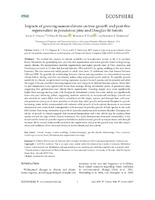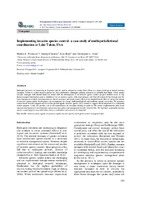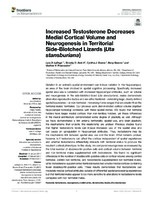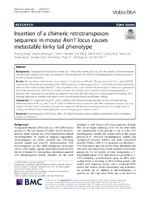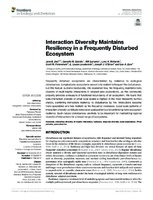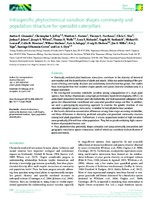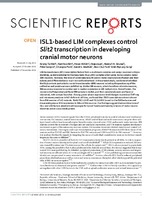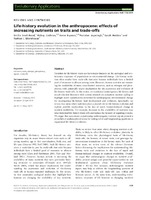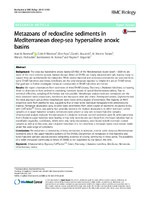If you have any problems related to the accessibility of any content (or if you want to request that a specific publication be accessible), please contact us at scholarworks@unr.edu.
Browsing Biology - Faculty Research by Title
Now showing items 67-86 of 142
-
.
.
.
Impact of asynchronous emergence of two lethal pathogens on amphibian assemblages
(2017)Emerging diseases have been increasingly associated with population declines, with co-infections exhibiting many types of interactions. The chytrid fungus (Batrachochytrium dendrobatidis) and ranaviruses have extraordinarily ... -
.
.
.
Impacts of growing-season climate on tree growth and post-fire regeneration in ponderosa pine and Douglas-fir forests
(2019)We studied the impacts of climate variability on low-elevation forests in the U.S. northern Rocky Mountains by quantifying how post-fire tree regeneration and radial growth varied with growing-season climate. We reconstructed ... -
.
.
.
Implementing invasive species control: a case study of multi-jurisdictional coordination at Lake Tahoe, USA
(2015)Biological invasions are increasing in frequency and the need to mitigate or control their effects is a major challenge to natural resource managers. Failure to control invasive species has been attributed to inadequate ... -
.
.
.
Inconsistent reproductive isolation revealed by interactions between Catostomus fish species
(2017)Interactions between species are central to evolution and ecology, but we do not know enough about how outcomes of interactions between species vary across geographic locations, in heterogeneous environments, or over time. ... -
.
.
.
Increased Testosterone Decreases Medial Cortical Volume and Neurogenesis in Territorial Side-Blotched Lizards (Uta stansburiana)
(2017)Variation in an animal's spatial environment can induce variation in the hippocampus, an area of the brain involved in spatial cognitive processing. Specifically, increased spatial area use is correlated with increased ... -
.
.
.
Independent Scientific Review under the Endangered Species Act
(2019)The directive from Congress in the Endangered Species Act obliging the US Fish and Wildlife Service and National Marine Fisheries Service along with other federal agencies to use the best available scientific information ... -
.
.
.
Insertion of a chimeric retrotransposon sequence in mouse Axin1 locus causes metastable kinky tail phenotype
(2019)Transposable elements (TEs) make up >50% of the human genome, and the majority of retrotransposon insertions are truncated and many are located in introns. However, the effects of retrotransposition on the host genes remain ... -
.
.
.
Interaction Diversity Maintains Resiliency in a Frequently Disturbed Ecosystem
(2019)Frequently disturbed ecosystems are characterized by resilience to ecological disturbances. Longleaf pine ecosystems are not only resilient to frequent fire disturbance, but this feature sustains biodiversity. We examined ... -
.
.
.
Intraspecific phytochemical variation shapes community and population structure for specialist caterpillars
(2016)Chemically mediated plant-herbivore interactions contribute to the diversity of terrestrial communities and the diversification of plants and insects. While our understanding of the processes affecting community structure ... -
.
.
.
Intrinsic protein disorder reduces small-scale gene duplicability
(2017)Whereas the rate of gene duplication is relatively high, only certain duplications survive the filter of natural selection and can contribute to genome evolution. However, the reasons why certain genes can be retained after ... -
.
.
.
ISL1-based LIM complexes control Slit2 transcription in developing cranial motor neurons
(2016)LIM-homeodomain (HD) transcription factors form a multimeric complex and assign neuronal subtype identities, as demonstrated by the hexameric ISL1-LHX3 complex which gives rise to somatic motor (SM) neurons. However, the ... -
.
.
.
Larval Performance in the Context of Ecological Diversification and Speciation in Lycaeides Butterflies
(3/12/2012)The role of ecology in diversification has been widely investigated, though few groups have been studied in enough detail to allow comparisons of different ecological traits that potentially contribute to reproductive ... -
.
.
.
LepNet: The Lepidoptera of North America Network
(2017)The Lepidoptera of North America Network, or LepNet, is a digitization effort recently launched to mobilize biodiversity data from 3 million specimens of butterflies and moths in United States natural history collections ... -
.
.
.
Life-history evolution in the anthropocene: effects of increasing nutrients on traits and trade-offs
(2015)Variation in life-history traits can have major impacts on the ecological and evolutionary responses of populations to environmental change. Life-history variation often results from trade-offs that arise because individuals ... -
.
.
.
Like a bat out of heaven: the phylogeny and diversity of the bat-winged slugs (Heterobranchia: Gastropteridae)
(2017)A molecular phylogeny is presented for 25 newly sequenced specimens of Gastropteridae. The present phylogeny was estimated by analysing the nuclear fragment 28S and two mitochondrial fragments cytochrome c oxidase I (COI) ... -
.
.
.
Loss of adult skeletal muscle stem cells drives age-related neuromuscular junction degeneration
(2017)Neuromuscular junction degeneration is a prominent aspect of sarcopenia, the age associated loss of skeletal muscle integrity. Previously, we showed that muscle stem cells activate and contribute to mouse neuromuscular ... -
.
.
.
Loss of Prune in Circadian Cells Decreases the Amplitude of the Circadian Locomotor Rhythm in Drosophila
(2019)The circadian system, which has a period of about 24 h, is import for organismal health and fitness. The molecular circadian clock consists of feedback loops involving both transcription and translation, and proper function ... -
.
.
.
Metazoans of redoxcline sediments in Mediterranean deep-sea hypersaline anoxic basins
(2015)The deep-sea hypersaline anoxic basins (DHABs) of the Mediterranean (water depth similar to 3500 m) are some of the most extreme oceanic habitats known. Brines of DHABs are nearly saturated with salt, leading many to suspect ... -
.
.
.
MicroRNAs control mRNA fate by compartmentalization based on 3 ' UTR length in male germ cells
(2017)Post-transcriptional regulation of gene expression can be achieved through the control of mRNA stability, cytoplasmic compartmentalization, 3' UTR length and translational efficacy. Spermiogenesis, a process through which ... -
.
.
.
miR-124 Regulates the Phase of Drosophila Circadian Locomotor Behavior
(2016)Animals use circadian rhythms to anticipate daily environmental changes. Circadian clocks have a profound effect on behavior. In Drosophila, for example, brain pacemaker neurons dictate that flies are mostly active at dawn ...
 University of Nevada, Reno
University of Nevada, Reno




